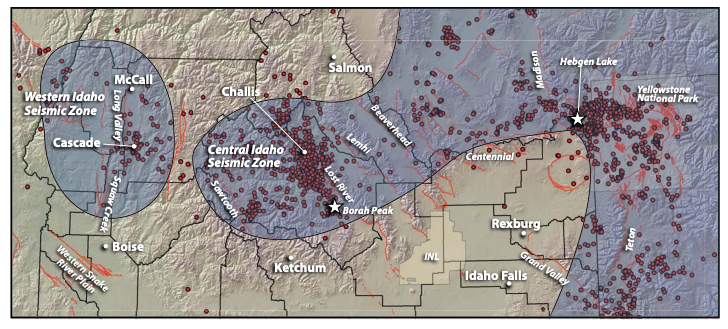Information about Earthquakes
Overview
 What to Expect
What to Expect
Residents in the Treasure Valley could experience shaking from nearby earthquakes in their lifetime. Earthquakes typically happen along plate boundaries, but can happen within plates too. Faults in the crust can be activated when forces within a plate stress the crust. Historically residents of the Treasure Valley have felt earthquakes a handful of times. The Borah Peak earthquake, a magnitude 6.9, happened in 1983. Though the epicenter was 130 miles from the Treasure Valley, residents felt moderate shaking. Pictures and unstable objects rattled and were displaced. In 2008, shaking from a magnitude 6.0 earthquake in Wells, Nevada was felt by thousands in Boise, but no damage was reported. (Sources: Tetra Tech, 2017, SE Idaho Earthquake Fact Sheet, IDGS-Putting Down Roots in EQ Country)
Worst-Case Scenario
The Squaw Creek, Jake’s Creek, and Big Flat Faults are N-S trending faults located about 25 miles north of the Treasure Valley and could produce magnitude 6.5 to 7.5 earthquakes. If an earthquake were to happen on one of those faults, Treasure Valley residents would feel strong to very strong shaking. Local dams could be compromised and cause flooding downstream. If shaking is strong enough the Treasure Valley could also see areas with liquefaction and landslides. Liquefaction is a phenomenon where ground that has high water content and is poorly held together can act like quicksand when it is shaken. An earthquake of this size would cause considerable damage to the Treasure Valley. (Sources: USGS Squaw Creek Scenario & IDGS-Putting Down Roots in EQ Country)
How to Prepare
- Practice ‘Drop, Cover, and Hold on
- Properly secure items that could fall
- Learn where utility shut offs are and when and how to turn them off
- Sign up for CodeRed emergency alerts
Local Resources
- Sign up for the Idaho State Alert and Warning System
- Ada County: earthquake information
- Idaho Geological Survey: earthquake hazards
- Idaho Geologic Survey: liquefaction maps
- U.S. Geological Survey: earthquake hazards program
How is this hazard impacted by a changing climate?
Earthquake processes are not controlled by climate. Read more about what causes earthquakes on the USGS webpage.
Written by Carson MacPherson-Krutsky and edited by Lee Liberty, geophysics professor, Boise State Geoscience Department